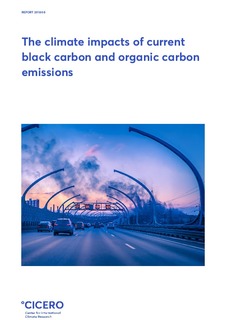| dc.description.abstract | In Part 1, we present a summary of recent research into the climate impact of black and organic carbon. There have been many developments on the research front in recent years, and this rapid pace is expected to continue. The strength of the climate impacts of black and organic carbon is governed by the amount of global emissions, how long the aerosols remain suspended in the air after emission, and how effective their various climate interactions are. Current estimates of annual emissions of both black and organic carbon are higher than they were a few years ago. Black carbon is currently estimated to have only a moderate global warming effect, but may have a stronger influence on regional temperatures and precipitation. Organic carbon emissions are still estimated to have a moderately cooling effect.
In Part 2, we use the conclusions from Part 1 to assess differences between emission regions and sectors in terms of climate impact of BC and OC. We emphasize here that the conclusions in the following pages are based on our assessment guided by recent literature, and as such are not necessary representative of the whole research community. In summary, we find that:
• The climate impacts of aerosols emitted in a given region may be both local and remote. There is no direct connection between the pattern of emission, radiative forcing and temperature change. The sensitivity of global temperature to black carbon emissions also differs by region. Hence, the mitigation potential of BC and OC (in terms of global temperature change) needs to be separately considered for each emission region.
• Presently, East Asia, South Asia and Southern Africa are the main BC emission regions, each causing around 0.01 °C of global warming. The Russia, Belarus, Ukraine and Caucasus region represents a similar amount of warming, but for much lower emissions (25% of those in East Asia), illustrating the regional difference in sensitivity to emissions.
• The residential sector (fuel for cooking and heating) emits the most BC, globally and in the main emissions regions. In East Asia, the energy sector also contributes strongly.
• The mitigation potential of warming BC is strongly dependent on co-emission with cooling OC. Transportation stands out as the sector with lowest co-emissions of OC, suggesting higher mitigation potential in regions where transportation contributes significantly to global BC emissions. North Africa and the Middle East, East Asia and South America are examples.
• BC has likely been a contributor to the recent strong Arctic warming. The sensitivity of Arctic temperature is highest for high latitude source regions, notably Europe and the Russia, Belarus, Ukraine and Caucasus regions. In absolute impact, East Asia and South Asia are the strongest contributors to Arctic warming through BC emissions.
• The climate impact of aerosols extends beyond temperature, to precipitation and extreme weather. However, we find that present knowledge is insufficient to quantify the impacts of present BC and OC emissions on global or regional precipitation patterns. This is an area of very active research, and will likely have progressed when the IPCC 6th Assessment Report is published. | nb_NO |
